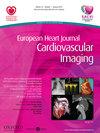Incremental prognostic value of fully-automatic machine-learning based global circumferential strain during a stress CMR exam
引用次数: 0
Abstract
Abstract Funding Acknowledgements Type of funding sources: None. Background Left ventricular global circumferential strain using cardiovascular magnetic resonance (CMR) is an accurate indicator to predict cardiovascular events. Although several studies have shown the excellent prognostic value of stress CMR, the prognostic value of stress global circumferential strain (sGCS) remains unknown. Aim To investigate the prognostic value of sGCS for predicting cardiovascular events using a fully automatic machine learning algorithm without human correction in consecutive patients referred for stress CMR. Methods Between 2016 and 2018, all consecutive patients referred for stress CMR were included and followed for the occurrence of major adverse cardiovascular events (MACE), defined by cardiovascular death or nonfatal myocardial infarction (MI). A fully automatic machine learning algorithm was trained and validated on unseen CMR studies (MAGNETOM Aera and Skyra, Siemens Healthcare, Erlangen, Germany) to assess the sGCS from short-axis cine images at stress. The algorithm combines multiple deep learning networks for detection and segmentation with an active contours approach. Cox regressions were performed to determine the prognostic value of sGCS. Results Among 2,906 consecutive patients who underwent stress CMR, the automatic sGCS was successfully computed in 2,859 (98.4%) patients (68% male, mean age 64±12 years). A total of 256 (8.8%) MACEs were observed during a median (IQR) follow-up period of 4.5 (3.7–5.3) years. Using Kaplan-Meier analysis, sGCS and the presence of inducible ischemia were significantly associated with the occurrence of MACE (hazard ratio, HR: 1.12 [95% CI, 1.08–1.17]; and HR: 8.48 [95% CI, 6.05–11.91], both p<0.001; respectively). After adjustment for traditional risk factors, inducible ischemia and late gadolinium enhancement (LGE), sGCS was an independent predictor of a higher incidence of MACE (adjusted HR: 1.12 [95% CI, 1.05–1.20]). Finally, sGCS showed an incremental prognostic value to predict MACE compared to a multivariable model including traditional risk factors, the presence of inducible ischemia and LGE (C-statistic improvement: 0.05, p = 0.007; NRI= 0.169; IDI= 0.097; both p<0.001). Conclusions Automatic sGCS has an incremental prognostic value to predict MACE above traditional risk factors, and other stress CMR parameters.应力CMR检查中基于全自动机器学习的全局周应变的增量预测价值
资金来源类型:无。背景:利用心血管磁共振(CMR)测量左心室总周应变是预测心血管事件的准确指标。虽然一些研究表明应力CMR具有良好的预后价值,但应力全局周向应变(sGCS)的预后价值尚不清楚。目的探讨sGCS在连续接受应激性CMR的患者中使用全自动机器学习算法预测心血管事件的预后价值。方法在2016年至2018年期间,纳入所有连续接受应激性CMR的患者,并随访主要不良心血管事件(MACE)的发生情况,MACE的定义为心血管死亡或非致死性心肌梗死(MI)。在未见过的CMR研究(MAGNETOM Aera和Skyra, Siemens Healthcare, Erlangen, Germany)中训练并验证了全自动机器学习算法,以评估应激下短轴电影图像的sGCS。该算法将用于检测和分割的多个深度学习网络与活动轮廓方法相结合。采用Cox回归来确定sGCS的预后价值。结果2,906例连续行应激性CMR的患者中,2,859例(98.4%)患者(68%为男性,平均年龄64±12岁)成功自动计算sGCS。在中位(IQR) 4.5(3.7-5.3)年的随访期间,共观察到256例(8.8%)mace。Kaplan-Meier分析显示,sGCS和诱导性缺血的存在与MACE的发生显著相关(风险比,HR: 1.12 [95% CI, 1.08-1.17];和HR: 8.48 [95% CI, 6.05-11.91],均为p<0.001;分别)。在对传统危险因素、诱导性缺血和晚期钆增强(LGE)进行校正后,sGCS是MACE较高发生率的独立预测因子(校正HR: 1.12 [95% CI, 1.05-1.20])。最后,与包括传统危险因素、诱导性缺血和LGE的多变量模型相比,sGCS在预测MACE方面显示出增加的预后价值(c -统计改善:0.05,p = 0.007;个新名词= 0.169;伊迪= 0.097;两个p&肝移植;0.001)。结论自动sGCS对MACE的预测价值高于传统危险因素和其他应激CMR参数。
本文章由计算机程序翻译,如有差异,请以英文原文为准。
求助全文
约1分钟内获得全文
求助全文

 求助内容:
求助内容: 应助结果提醒方式:
应助结果提醒方式:


